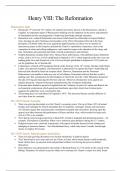Summary
Summary AQA A-Level 1C Tudors: Henry VIII Revision Notes (A* achieved)
- Course
- Institution
- Book
Detailed revision notes for Henry VIII (), part of the AQA A-Level 1C The Tudors: England, specification. Notes are easy to understand and full of relevent evidence to improve your essays. Areas covered include: renaissance ideas, the divorce, religious change, rebellions, key ministers, governanc...
[Show more]




